
The sika deer, also known as the Northernspotted deer or the Japanese deer, is a species of deer native to much of East Asia and introduced to other parts of the world. Previously found from northern Vietnam in the south to the Russian Far East in the north, it is an uncommon species that has been extirpated in most areas of its native range, except in Japan, where it is overabundant and present in very large numbers.

Eld's deer, also known as the thamin or brow-antlered deer, is an endangered species of deer endemic to South and Southeast Asia.
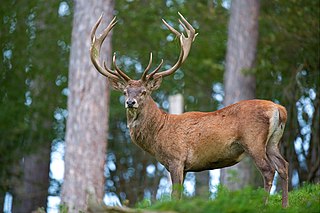
The red deer is one of the largest deer species. A male red deer is called a stag or hart, and a female is called a hind. The red deer inhabits most of Europe, the Caucasus Mountains region, Anatolia, Iran, and parts of western Asia. It also inhabits the Atlas Mountains of Northern Africa; being the only living species of deer to inhabit Africa. Red deer have been introduced to other areas, including Australia, New Zealand, the United States, Canada, Peru, Uruguay, Chile and Argentina. In many parts of the world, the meat (venison) from red deer is used as a food source.

The Irish elk, also called the giant deer or Irish deer, is an extinct species of deer in the genus Megaloceros and is one of the largest deer that ever lived. Its range extended across Eurasia during the Pleistocene, from Ireland to Lake Baikal in Siberia. The most recent remains of the species have been radiocarbon dated to about 7,700 years ago in western Russia.

A harem is an animal group consisting of one or two males, a number of females, and their offspring. The dominant male drives off other males and maintains the unity of the group. If present, the second male is subservient to the dominant male. As juvenile males grow, they leave the group and roam as solitary individuals or join bachelor herds. Females in the group may be inter-related. The dominant male mates with the females as they become sexually active and drives off competitors, until he is displaced by another male. In some species, incoming males that achieve dominant status may commit infanticide.

Thorold's deer is a threatened species of deer found in grassland, shrubland, and forest at high altitudes in the eastern Tibetan Plateau. It is also known as the white-lipped deer for the white patches around its muzzle.
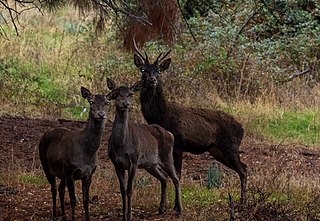
The Barbary stag, also known as the Atlas deer or African elk, is a subspecies of the red deer that is native to North Africa. It is the only deer known to be native to Africa, aside from Megaceroides algericus, which went extinct approximately 6,000 years ago.

The Kashmir stag, also called hangul, is a subspecies of Central Asian red deer endemic to Kashmir and surrounding areas. It is found in dense riverine forests in the high valleys and mountains of Jammu and Kashmir and northern Himachal Pradesh. In Kashmir, it is found primarily in the Dachigam National Park where it receives protection, and elsewhere it is more at risk. In the 1941s, the population was between 3000 and 5000 individuals, but since then habitat destruction, over-grazing by domestic livestock and poaching have reduced population dramatically. Earlier believed to be a subspecies of red deer, a number of mitochondrial DNA genetic studies later had the hangul as a part of the Asian clade of the elk. The IUCN and American Society of Mammalogists, however, include it in the new grouping of Central Asian red deer, with the Kashmir stag being the type subspecies. The 2008 census counted 160 mature individuals in the Kashmir valley and northern Chamba in Himachal Pradesh. According to the census in 2019, there were only 237 hanguls. According to 2023 census, the numbers have improved to 289.
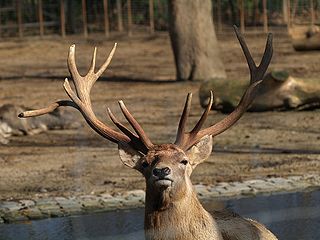
The Bactrian deer, also called the Bukhara deer, Bokhara deer, or Bactrian wapiti, is a lowland subspecies of Central Asian red deer native to Central Asia. It is similar in ecology to the related Yarkand deer in that it occupies riparian corridors surrounded by deserts. The subspecies are separated from one another by the Tian Shan Mountains and probably form a primordial subgroup of the red deer.

The Tibetan red deer also known as shou, is a subspecies of elk/wapiti native to the southern Tibetan highlands and Bhutan. Once believed to be near-extinct, its population has increased to over 8,300, the majority of which live in a 120,000-hectare nature reserve established in 1993 in Riwoqê County, Qamdo Prefecture, Tibet Autonomous Region, China. Some have been kept at the beginning of the 20th century in London, and in a small zoo south of Lhasa.

The Manchurian wapiti is a subspecies of the wapiti native to East Asia.
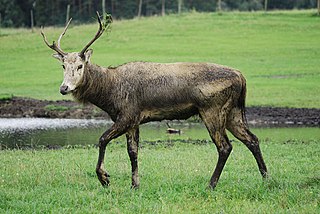
The Cervinae or the Old World deer, are a subfamily of deer. Alternatively, they are known as the plesiometacarpal deer, due to their ankle structure being different from the telemetacarpal deer of the Capreolinae.
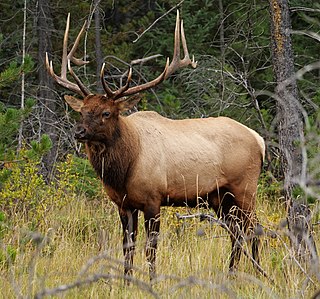
The elk, or wapiti, is one of the largest species within the deer family, Cervidae, and one of the largest terrestrial mammals in its native range of North America and Central and East Asia. The word "elk" originally referred to the European variety of the moose, Alces alces, but was transferred to Cervus canadensis by North American colonists. The name "wapiti" derives from a Shawnee and Cree word meaning "white rump" for the distinctive light fur in the rear region.

The Central Asian red deer, also known as the Tarim red deer is a deer species native to Central Asia, where it used to be widely distributed, but is scattered today with small population units in several countries. It has been listed as Least Concern on the IUCN Red List since 2017. It was first described in the mid-19th century.

The tule elk is a subspecies of elk found only in California, ranging from the grasslands and marshlands of the Central Valley to the grassy hills on the coast. The subspecies name derives from the tule, a species of sedge native to freshwater marshes on which the Tule elk feeds. When the Europeans first arrived, an estimated 500,000 tule elk roamed these regions, but by 1870 they were thought to be extirpated. However, in 1874–1875 a single breeding pair was discovered in the tule marshes of Buena Vista Lake in the southern San Joaquin Valley. Conservation measures were taken to protect the species in the 1970s. Today, the wild population exceeds 4,000. Tule elk can reliably be found in Carrizo Plain National Monument, Point Reyes National Seashore, portions of the Owens Valley from Lone Pine to Bishop, on Coyote Ridge in Santa Clara Valley, San Jose, California and in Pacheco State Park and areas surrounding San Luis Reservoir near Los Banos, California.

The Altai wapiti, sometimes called the Altai elk, is a subspecies of Cervus canadensis found in the forest hills of southern Siberia, northwestern Mongolia, and northern Xinjiang province of China. It is different from the Tian Shan wapiti in being smaller and paler in color.
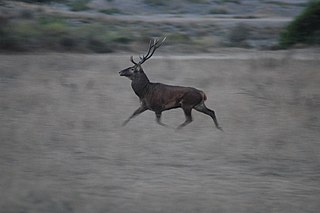
The Corsican red deer, also known simply as the Corsican deer or Sardinian deer, is a population of red deer found on the Mediterranean islands of Sardinia (Italy) and Corsica (France).
The Alashan wapiti is an Asian subspecies of wapiti, or elk as they are called in North America.
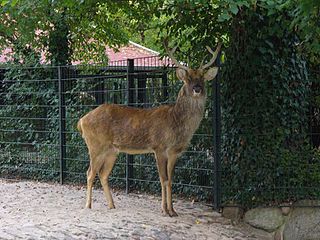
Rucervus is a genus of deer from India, Nepal, Indochina, and the Chinese island of Hainan. The only extant representatives, the barasingha or swamp deer and Eld's deer, are threatened by habitat loss and hunting; another species, Schomburgk’s deer, went extinct in 1938. Deer species found within the genus Rucervus are characterized by a specific antler structure, where the basal ramification is often supplemented with an additional small prong, and the middle tine is never present. The crown tines are inserted on the posterior side of the beam and may be bifurcated or fused into a small palmation.



















